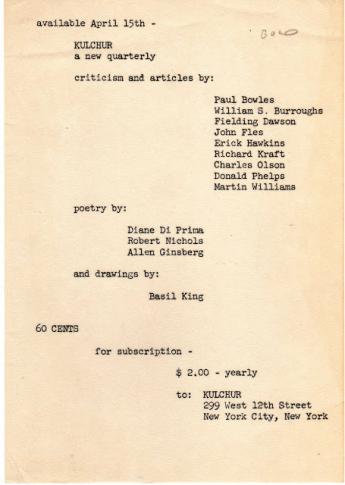Tavistock Books
The Mimeo Revolution - Secret Location on the Upper East Side

By Jed Birmingham
As much as I hate to admit it, Kulchur is one of the great magazines of the Mimeo Revolution. The mag irks because it proves false my notion that good funding translates into a bad mag. On the contrary, Kulchur is great precisely because it is well-funded. It just looks money in terms of design (even if Lita Hornick did not get her money’s worth with the printers) and the contents are a wealth of information on the New York art scene in all its facets from film, art, literature, and theater. Hornick got great reviews and chronicles from great writers because she paid for them. In this case, she got her money’s worth.
Nowhere is Hornick’s money more apparent than in a subscription form I found in Kulchur 19. (Reminder: Collectors and archivists should gather this shit up; it is important.) First and foremost, Mimeo Revolution mags generally do not generate formal business documents of this nature. Just compare the announcement for the first issue of Kulchur against Hornick’s subscription form in issue 19. In my mind, mimeos did not require blank forms or letterhead. They were too human and personal for that. Mimeo publishers were not bureaucracies. No subscription forms because they did not accept subscriptions or in the case of a mag like Floating Bear or Semina, they were not for sale at all. Gift economies are not awash in gray paper. Semina’s business correspondence is mail art. I suspect that this is another of my personal myths about the Mimeo Revolution.
I just read Lisa Gitelman’s Paper Knowledge, which attempts to lay the groundwork for a media history of documents that analyzes and contextualizes business documents and job printing, such as the Kulchur subscription form. I envision a book that takes The Kulchur Foundation, Fuck You Press, City Lights, Grove Press, Cornith/Totem Press, Floating Bear and Semina and examines them as counterculture businesses and economies. I think studies of this type have been done with Hippie capitalism. I wonder what a similar case study of the Mimeo Revolution would turn up. If one wants to study the Mimeo Revolution as a business, the archives of The Kulchur Foundation would be an interesting place to start. In fact there are substantial archives for all the entities listed above, with maybe the exception of Semina, but this lack is an important part of the Semina business model if you can call it that.
I found the most interesting part of the Kulchur subscription form to be the publisher’s address: 888 Park Avenue. Compare this to 299 West 12th Street, which was constructed in 1929 to rival the residences of Central Park West, for the first issue of Kulchur. Park Avenue was the location of Lita Hornick’s apartment and that residence is one of the most famous and exclusive in New York City. It housed a Kennedy (Caroline) and kept out an IMAX CEO recently because his stock portfolio did not pass muster with the homeowner association. In today’s market, apartments are selling for $13 million. I doubt collation parties took place at 888 Park Avenue (like at, say Apartment 7C), but in the Mimeo Revolution the cocktail party was just as crucial for funding and survival. The Secret Location on the Upper East Side, the home of sponsors, collectors, cultural tourists, and, as in the case of Hornick, publishers, is just as much the prime real estate of the Mimeo Revolution as the Lower East Side. Nowadays it is all prime real estate for sure. An apartment at 299 West 12th Street goes for over $4 million. If 888 Park Avenue housed a Kennedy, 299 West 12th housed an Aniston (Jennifer). The Kulchur subscription forms if opened for study could tell an interesting story about the business and the real estate of the alternative press and the counterculture.
***
Posted on Mimeo Mimeo – Artists’s Book, Typography and the Mimeo Revolution. Presented here, including pictures, by permission of the author.


